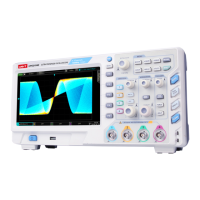4.3 Storage Depth
The storage depth is the number of waveforms that can be stored in the oscilloscope during a trigger acquisition. It reflects
the memory storage capacity of the acquisition.
Memory depth, sampling rate and wavelength should meet the following formula:
Memory depth = Sampling rate × Horizontal time base × Horizontal grids
UPO2000E comes with 56Mpts memory depth (per channel). Press ACQUIRE Memory depth to set the memory depth to
automatic, 28k, 280k, 2.8M, 28M or 56M. The default is automatic.
Trigger determines when the oscilloscope starts to collect data and display waveform. Once the trigger is correctly set, it can
convert unstable signals into meaningful waveforms. In the beginning of data acquisition, it first collects enough data to plot
a waveform starting on the left of the trigger point, and continuously collects data while waiting for the trigger. When a trigger
is detected, the device continuously acquires enough data for plotting a waveform to the right of the trigger point.
In this chapter UPO2XX4E will be used as the example.
5.1 Trigger System Interpretation
(1) Trigger Source
Trigger source is signal for trigger generating. Triggers can be obtained from a variety of sources such as input channels
(CH1, CH2, CH3, CH4), external trigger (EXT, EXT/5), AC Line, etc.
Input channel
Select any one of the analog signal input terminal CH1~CH4 on the oscilloscope front panel as a trigger signal.
External Trigger
Select the EXT Trig (EXT or EXT /5 input terminal) input signal from the oscilloscope rear panel as a trigger signal.
For example, the external clock input can be used on the EXT Trig terminal as a trigger source, including EXT and
EXT/5. EXT trigger level ranges from -0.9V ~ +0.9V can be set. EXT/5 trigger level range is increased to -4.5V~ +4.5V.
AC Line
Power supply, used to observe signals related to mains, such as relationship between lighting equipment and power
supply equipment, so as to achieve stable synchronization.
Chapter 5 Trigger System Settings
(2) Trigger Mode
Trigger mode determines the behavior of the oscilloscope during a trigger event. This oscilloscope provides three kinds of
trigger modes: auto, normal, and single trigger.
Auto trigger:
When there is no trigger signal, the system automatically runs, collects and displays data. When the trigger signal is
generated, it automatically switches to trigger scanning and signal synchronization.
Note: This mode allows 100ms/div or slower time shift without triggering in ROLL mode.
Normal trigger:
The oscilloscope can only collect data when the trigger condition is satisfied. When it is not triggered, the oscilloscope
will stop data acquisition and wait for the trigger signal.
Single trigger:
Press once the SINGLE key and the oscilloscope will wait for the trigger. When the instrument detects a trigger, the
waveform is sampled and displayed, and enters the STOP state. Press the SINGLE button on the front panel of the
oscilloscope to quickly enter the single trigger mode.
22

